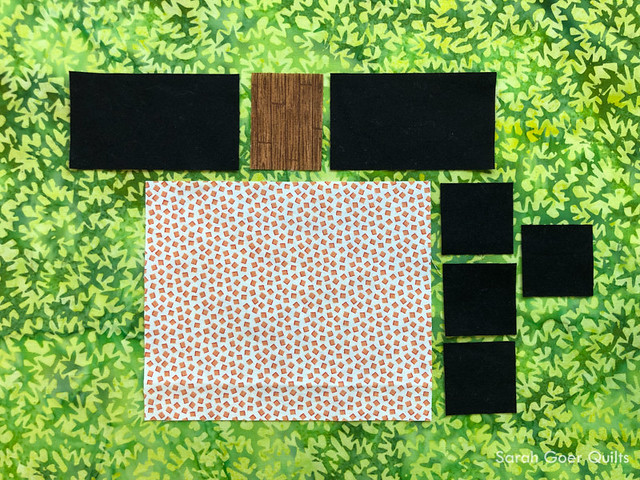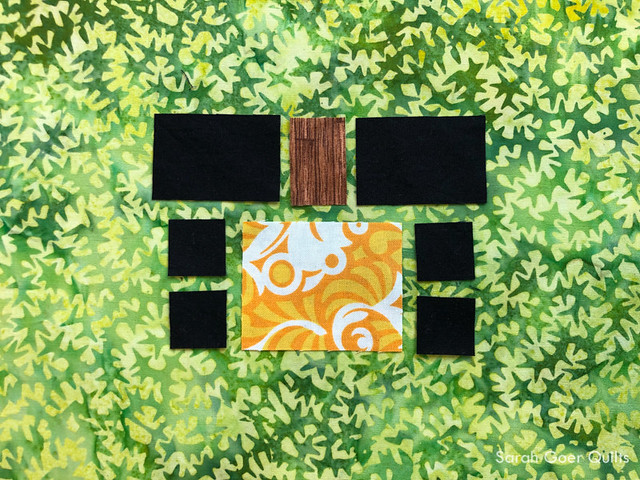Welcome to my stop on the Back to School Blog Hop for 2022! Now that my kids have been back in school for a few weeks, I've gotten back into the groove of getting into my studio more regularly. I've done some sewing, some tidying, some planning, and some writing. :-)

My newest class is Building an Improv Toolbox. (P.S. You can take it with me on November 5!) In improv I often don't concern myself with things lining up precisely, but even then, sometimes I do want it to happen. These tips are for those times... in addition to any precise piecing for patterns and traditional blocks.
First Tip - Press Seams Open
I like my seams pressed open for two reasons. The first is that I do a lot of my own quilting and really like how flat these seams lay when I'm doing free motion quilting on my domestic machine. Second, I find it really helps me with the precision! I've never had great luck with nested seams landing exactly where they should. This method helps me achieve perfect points when I want them.
Use a thin, high quality thread (my preference is Aurifil 50wt cotton thread for piecing) and reduce your stitch length a smidge for best results.
Second Tip - Use Pins
I don't use pins all the time, but when I want something to perfectly match up, I pull out the pins. I start by sticking one pin perpendicularly through the fabric -- right through the seam and 1/4" from the edge of the fabric. Then I go through the second layer of fabric with the same pin, stabbing through the seam 1/4" from the edge of the fabric. Obviously, we can't sew with a pin perpendicular to the fabric, so next I take two more pins and pin on either side of my guide pin. Then I remove that perpendicular guide pin and head to the machine.

Top view of pin through seams, 1/4 inch from the top edge.

Bottom view of pin through seams, 1/4 inch from the top edge.

Pin on either side of the seams.

Remove initial guide pin.

Final seam, pressed open and flat.
Third Tip - Just Sew a Little Bit
If that desired perfect point is in the middle of a long seam there is nothing worse than realizing it's a bit off and having to seam rip the entire seam. When these precise points fall in the middle of a long seam I just sew about an inch on either side of the point. With seams pressed open and pins as described above, I sew a couple inches including the point. Then I can take it to the ironing board and even temporarily press the seam as desired to get a good look at the precision. If I'm happy, I press the seams closed and return to my machine to sew the entire seam (right over my previous stitching for the test patch). If I'm unhappy with the precision then I only have a couple inches to rip out to try again.

Be sure to visit every stop on the hop!
Sept. 15 - Geeky Bobbin - Press for Success! - https://geekybobbin.com
Sept. 16 - Katie Mae Quilts - Storage Solutions From The School Supplies Section - https://katiemaequilts.com/blog
Sept. 17 - Quilting Jetgirl - Make A Design Wall You Can Use Your Hera Marker Against - https://quiltingjetgirl.com/
Sept. 18 - Karen Bolan - How to Get Perfect Tension - https://www.karenbolan.com
Sept. 19 - Devoted Quilter - How To Trim HSTs Without A Specialty Ruler - https://www.devotedquilter.com
Sept. 20 - Sarah Ruiz - Calculating Quilt Backing and Binding Fabric Requirements - https://saroy.net
Sept. 21 - Andy Knowlton - How To Sew Quilt Blocks With Partial Seams - https://www.abrightcorner.com/
Sept. 22 - Lisa Ruble - Curved Piecing Doesn't Have To Be Scary (Or Perfect!) - https://www.quiltyzest.com
Sept. 23 - Sarah Goer Quilts (you're here!) - Tips for Piecing Precise Points - https://sarahgoerquilts.com
Sept. 24 - Faith and Fabric - Spinning Intersections On Four Patch Blocks - The Easy Way! - https://faithandfabricdesign.com
Sept. 25 - Judit Hajdu - Draw String Bag - For Lunch Or Gym - https://www.quiltfox-design.com
Sept. 26 - Sugar Sand Quilt Co. - The Care And Feeding Of The Wild Longarm Quilter - https://sugarsandquilts.com/
Sept. 27 - Hilary Jordan - Quick & Easy Pattern Matching Technique for Quilt Backings - https://byhilaryjordan.com/
Sept. 28 - True Blue Quilts - Sketch Then Stitch...Better FMQ Through Doodling - https://truebluequilts.com
Sept. 29 - Sunflower Quilting - A Quilting Tip - https://sunflowerstitcheries.com
Sept. 30 - Slightly Biased Quilts - Perfect Hand Binding Tips - www.slightlybiasedquilts.com













 This Scrappy Slab version is made from a 6 3/4" x 7 3/4" scrap of orange fabric, with 1 3/4" corner squares. The stem is 1 3/4" x 2 1/4". You can find all my tips for making your own Scrappy Slab in my
This Scrappy Slab version is made from a 6 3/4" x 7 3/4" scrap of orange fabric, with 1 3/4" corner squares. The stem is 1 3/4" x 2 1/4". You can find all my tips for making your own Scrappy Slab in my